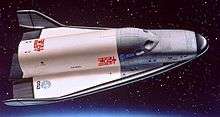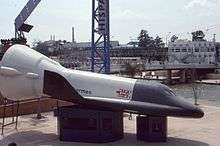Hermes (spacecraft)
| Hermès | |
|---|---|
 Artist's impression of Hermes (ESA) | |
| Country | France |
| Contract award | November 1987 |
| Status | Project cancelled |
| First flight | Not built |
| Crew members | Three astronauts |
| Time spent in space | planned 30 to 90 days |
Hermes was a proposed spaceplane designed by the French Centre National d'Études Spatiales (CNES) in 1975, and later by the European Space Agency. It was superficially similar to the US X-20. France proposed in January 1985 to go through with Hermes development under the auspices of the ESA.[1] Hermes was to have been part of a manned space flight program. It would have been launched using an Ariane 5. The project was approved in November 1987, with an initial pre-development phase from 1988 to 1990, with a green light for full-rate development depending on the outcome of the phase. The project suffered numerous delays and funding issues. It was canceled in 1992 since neither cost nor performance goals could be achieved. No Hermes shuttles were ever built.
Configuration
Hermes was to be launched on top of an Ariane 5 launcher and would consist of two parts: one part, a cone-shaped Resource Module which attached to the rear of the vehicle would be left behind before re-entry. Only the space plane itself would re-enter Earth's atmosphere and land.
In the configuration envisioned prior to project termination, Hermes would carry three astronauts and a 3,000 kg pressurized payload. The final launch weight would be 21,000 kg, which was seen as the upper limit of what an extended Ariane 5 could lift. The Hermes would be 19.00 m in length.
Landing sites
Possible landing sites for the shuttle would be:
- Guiana Space Centre
- Fort de France island (Martinique Aimé Césaire International Airport)
- Bermudas
- Istres (Istres-Le Tubé Air Base)
Typical missions
Four typical missions were proposed:
- Experiments are made on board, while in an equatorial 800 km orbit
- Flights to NASA's space station Freedom at a 28.5 degree orbit
- Flights to ESA's space station Columbus at a 60 degree orbit.
- Flights to ESA's unmanned remote sensing Polar Platform at a 98 degree 500 km orbit
Development
To ensure European autonomous access to space, in the mid-1980s the French space agency CNES pushed for a European shuttle mimicking those of the Soviet Union and the United States. The European Space Agency approved the project, dubbed Hermes, in November 1987. It was envisioned that Hermes would service a small space station, the Columbus Man-Tended Free Flyer (MTFF), built primarily by the German and Italian Industry in the frame of the Columbus program.
Hermes was to be developed in two phases.
Phase 1: Study and pre-development.
This phase was scheduled to end in 1990. Initially the plans called for a capacity to lift 6 astronauts and 4,550 kg of cargo, but after the Challenger disaster, it was felt necessary to include ejection capacity of some form to give astronauts at least a small chance of survival in case of catastrophe. Accordingly, the six seats were now curtailed to only three regular ejection seats, which were chosen over an entirely ejecting crew capsule that would have given the crew an escape option at heights over 28 km. The cargo capacity was limited to 3,000 kg. Hermes would not be able to place objects into orbit as its cargo hold could not be opened; again this option was abandoned due to weight concerns.
Although Hermes was originally seen as being entirely reusable (up to 30 successive re-entries without major servicing), problems aligning the capacity of the Ariane 5 launcher with the design of Hermes itself forced it to leave behind its rear part, the Resource Module, before re-entry. A newly built resource module would then be attached to the Hermes space plane and the entire structure would be launched again.
Phase 1 was not completed until the end of 1991 and by then the political climate surrounding Hermes had changed considerably. The Iron Curtain had been lifted and the Cold War was ending. As a result, ESA decided to interject a year-long "reflection" period to examine if it still made sense for Europe to build its own space shuttle and space station or if new partners could be found to share cost and development.
Officially, Phase 1 completed at the end of 1992, after a year of reflection.
Phase 2: Final development, manufacture & initial operations.
This phase was never properly started, as ESA and the Russian Aviation and Space Agency (RKA) had agreed to cooperate on future launchers and a replacement space station for Mir. Economic concerns prevented RKA from properly participating in a future launcher program, but at this point most of ESA's crew transport capabilities had been reoriented towards a capsule type system (as opposed to the glider system that Hermes represented) which was what the joint Russian/European designs called for.
When both Russia and ESA joined up with NASA to build the International Space Station, the immediate need for a European crew transport system disappeared as both Russia and the USA had existing capabilities that did not need expansion. Accordingly, ESA decided to abandon the Hermes project.
Partners
The primary companies involved in Hermes were Aérospatiale and Dassault-Breguet, both French. Arianespace built the Ariane 5 launcher and was seen as a strong candidate for running the Hermes infrastructure. No contract was ever signed, however.
Hardware and mock-ups
- A full-scale mock-up (built by CNES in 1987) is stored in Paris – Le Bourget Airport for repairs and perhaps future display
 Hermes 1:1 mock-up on display in 1992
Hermes 1:1 mock-up on display in 1992 - A 1/7 scale model (built by EADS) is on display at the Bordeaux-Mérignac Airport
See also
- Hopper, an unmanned, reusable satellite launch system that was developed and ultimately canceled by the ESA in the early 2000s.
- Intermediate eXperimental Vehicle, European lifting body spacecraft tested in February 2015
- E.S.S Mega, a 1991 space simulation game for MS-DOS, that feature the Hermes shuttle, along with other ESA vehicles.
- SOAR, Swiss private spacecraft derived from Hermes
References
- ↑ Martin Bayer, Hermes: Learning from our mistakes, Space Policy, Volume 11, Number 3, August 1995, pp. 171-180(10)
External links
- Hermes at Astronautix.com
- Hermes at Aerospaceguide.net
- 1:1 Mockup photos, including cockpit
- HERMES, l' avion spatial inachevé...

.jpg)

